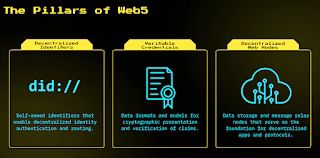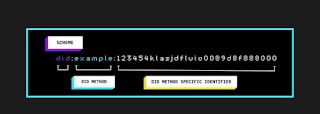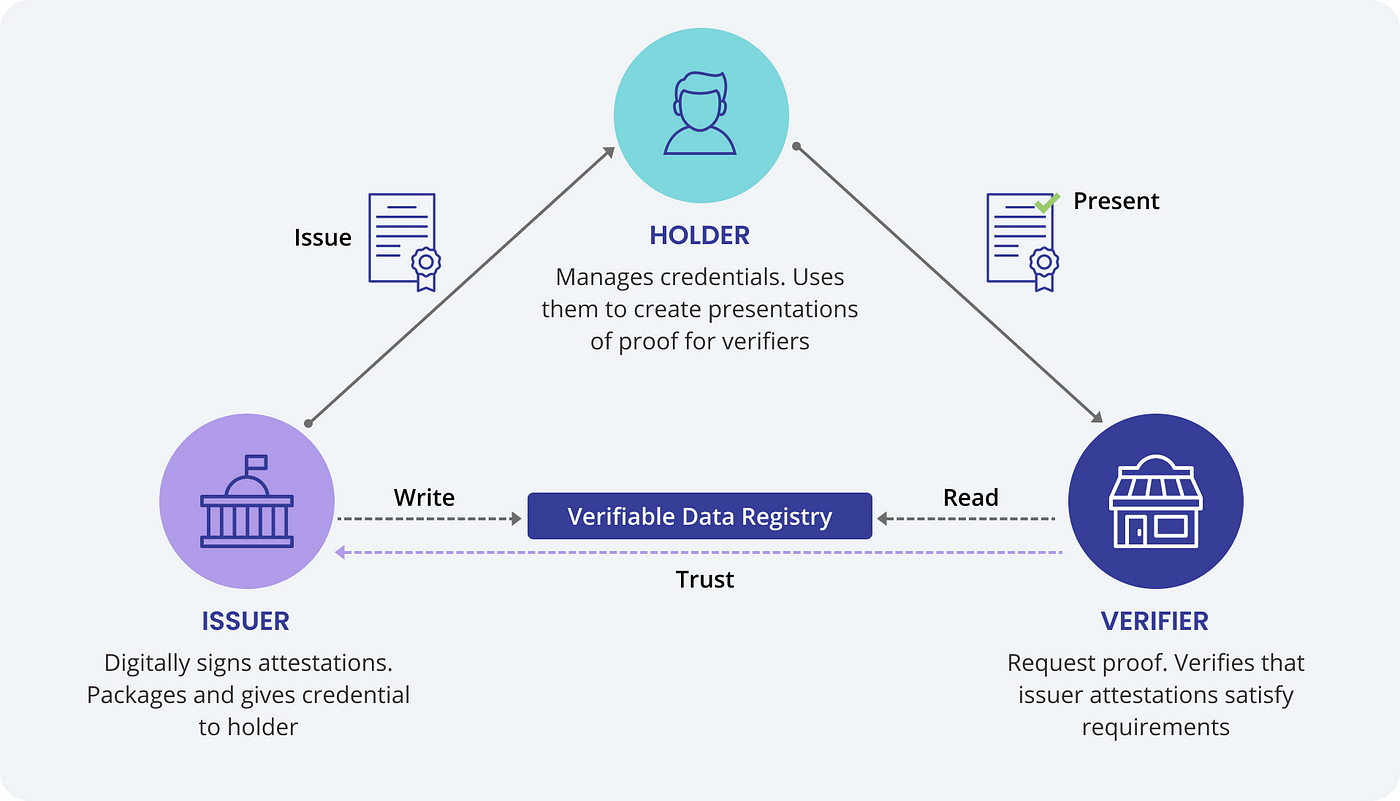Web5: Revolutionizing Web Identity and Data Management.
 AbubakarAbdulmajeed
AbubakarAbdulmajeedTable of contents
- Introduction to Web5
- Understanding the Genesis: Web5's Roots in Web3 and Web2
- Unlocking Digital Autonomy: Navigating the Decentralized Landscape with DIDs, DWN, and Verifiable Credentials.
- Decentralized Identifiers (DIDs) : Empowering Self-Ownership
- How DIDs Work
- Decentralized Web Nodes:
- Verifiable Credentials (VCs): Reinventing Digital Identity.
- Web5 Use Cases: Unveiling Practical Applications.
Introduction to Web5
Imagine a digital realm where your online identity isn't tethered to centralized platforms like Google, Twitter, or Instagram. Enter Web5, a revolutionary concept offering decentralized identity and data storage, giving users control over their unique identifiers. With Web5 , you can securely store your identifier in your own storage and choose who to share it with, ushering in a new era of privacy and autonomy.
Understanding the Genesis: Web5's Roots in Web3 and Web2
Web5, introduced in June 2022 by TBD, emerged from the convergence of two influential concepts: Web3 and Web2. Web3 operates on blockchain-based smart contracts, while Web2 thrives on centralized platforms such as Twitter and Facebook. The fusion of these elements birthed Web5, a solution addressing the pressing issues of data privacy and security.
Unlocking Digital Autonomy: Navigating the Decentralized Landscape with DIDs, DWN, and Verifiable Credentials.

Credit Right: Angie Jones
In the ever-evolving realm of digital transformation , the advent of decentralized technologies has sparked a revolution in how we manage and control our online identities and data. At the heart of this groundbreaking shift are three pivotal elements: Decentralized Web Nodes(DWNs), Decentralized Identifiers (DIDs), and Verifiable Credentials. Together, they form a dynamic trio reshaping the narrative of digital interaction , promising users unprecedented levels of autonomy, security, and trust. In this exploration , we delve into core functionalities of DWNs , the empowering capabilities of DIDs, and the game-changing potential of Verifiable Credentials, ushering in a new era where individuals hold the keys to their digital destinies.
Decentralized Identifiers (DIDs) : Empowering Self-Ownership
At the core of Web5 is the concept of Decentralized Identifiers (DIDs). These are unique identifiers, self-generated and self-owned, acting as addresses in decentralized platforms. DIDs can represent individuals, organizations, or entities, enabling secure communication and data sharing based on the user's preferences.
How DIDs Work

Credit Right: Angie Jones
Through DIDs, users can point to a specific subject (person, organization, or thing) on the decentralized platform. This address becomes a gateway for sending messages and sharing data securely, empowering users with control over the information they wish to disclose.
Decentralized Web Nodes:
A Decentralized Web Node (DWN) serves as a foundational element for managing data and facilitating communication in decentralized systems. It acts as both a storage repository and a messaging relay system, enabling entities to locate public or private permissioned data associated with a Decentralized Identifier. Essentially, a DWN empowers individuals to take control of their data by offering features such as data ownership, backup capabilities, and seamless data transmission. Users can not only store and retrieve information but also engage in bidirectional data exchange.
Crucially, the DWN incorporates mechanisms that govern access to its functionalities through permissions and protocols.
Permissions dictate the level of access granted to others, encompassing the ability to read, write, or delete specific data records within the node. This fine-grained control ensures data security and privacy, aligning with the decentralized ethos.
Moreover, the DWN operates on defined protocols, establishing a structured framework for data management. These protocols include the ability to define data types (schema) and specify authorization parameters for decentralized web applications (DWA).
This standardized approach ensures interoperability and seamless integration of diverse decentralized applications within the decentralized web ecosystem.
In summary, a Decentralized Web Node not only empowers individuals with data ownership and control but also establishes a secure and structured environment for decentralized data storage and communication, fostering the principles of decentralization, privacy, and user autonomy.
Verifiable Credentials (VCs): Reinventing Digital Identity.
Verifiable Credentials are digital credentials , they allow you provide specific attributes of your identity without relying on centralized authority.
A Verifiable Credential (VC) is a cryptographically-signed statement made by an issuer about a holder (or subject). VCs operate within a three-party model: the Issuer, the Holder (or Subject), and the Verifier.
In the context of a Verifiable Credential (VC), the issuer is the entity making the claim, establishing credibility. The subject within the realm of verifiable claims is the focal point of information or the individual to whom a specific claim is attributed. The verifier on the other hand is responsible for assessing and confirming the validity and authenticity of claims or credentials presented by a subject.

Three party model diagram, from Affinidi Pet. Ltd .
Web5 Use Cases: Unveiling Practical Applications.
Web5, with its innovative features, unfolds a myriad of practical applications that revolutionize the way we address real-world scenarios. Let's delve deeper into the diverse use cases:
Enhanced Data Security: Web5 emerges as a formidable guardian of data security by ushering in a decentralized storage paradigm. Unlike traditional models where data is concentrated in central repositories, Web5 disperses information across a network of nodes, significantly mitigating the risk of centralized breaches. This approach not only fortifies the security posture of digital ecosystems but also instills a sense of confidence among users and businesses.
Privacy Control: In the era of Web5, privacy is not just a buzzword but a tangible reality. Users wield unprecedented authority over their personal information, dictating who can access it. This empowerment fosters a culture of consent and autonomy, addressing growing concerns about data privacy. Web5 redefines the relationship between users and their digital footprint, putting control back into the hands of those generating the data.
Transparent Transactions: Web5 introduces a new era of transparency and security in digital transactions. Through its decentralized architecture, Web5 ensures that transactions are not only secure but also transparent. The blockchain technology that underpins Web5 provides an immutable record of transactions, fostering trust in digital interactions. This increased transparency is a pivotal step towards building robust and reliable digital economies.
Identity Verification: Web5 leverages Verifiable Credentials to streamline and revolutionize identity verification processes. The days of cumbersome and time-consuming identity checks are over, as Web5 offers a seamless and efficient method for verifying identities. The reliability of these verifiable credentials enhances the overall trustworthiness of digital identities, benefiting both users and service providers.
Resilient Network Infrastructure: Decentralized Web Nodes emerge as the unsung heroes in ensuring a resilient network infrastructure. In the face of potential disruptions, these nodes play a crucial role in maintaining connectivity and minimizing the impact of unforeseen events. Web5's architecture ensures that no single point of failure exists, making the network robust and resilient. This resilience is essential for critical services that rely on continuous and uninterrupted connectivity.
Ultimately, Web5 emerges as a transformative force in reshaping how we navigate the digital landscape. By decentralizing identity and data management, it offers a paradigm shift towards increased privacy, security, and user control. Embrace the future with Web5, where the power lies in the hands of the users.
Subscribe to my newsletter
Read articles from AbubakarAbdulmajeed directly inside your inbox. Subscribe to the newsletter, and don't miss out.
Written by
